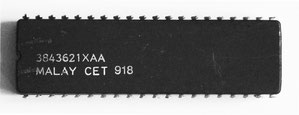80x87 Floating Point Units

80x87 is a floating point-related subset of the x86 architecture instruction set. It originated as an extension of the 8086 instruction set in the form of optional floating point coprocessors that worked in tandem with corresponding x86 CPUs. These microchips had names ending in "87". The x87 instruction set includes instructions for basic floating point operations such as addition, subtraction and comparison, but also for more complex numerical operations, such as the computation of the tangent function and its inverse, for example.
Most x86 processors since the Intel 80486 have had these x87 instructions implemented in the main CPU but the term is sometimes still used to refer to that part of the instruction set. Before x87 instructions were standard in PCs, compilers or programmers had to use rather slow library calls to perform floating-point operations, a method that is still common in (low-cost) embedded systems.
8087 Class
The Intel 8087, announced in 1980, was the first x87 floating-point coprocessor for the 8086 line of microprocessors.
Intel C8087-2
|
C8087-2 Specification Details |
Show | |||||||||||||||||||||
|
||||||||||||||||||||||
Intel D8087
|
D8087 Specification Details |
Show | |||||||||||||||||||||
|
||||||||||||||||||||||
Intel D8087-1
|
D8087-1 Specification Details |
Show | |||||||||||||||||||||
|
||||||||||||||||||||||
80287 Class
The 80287 (i287) was the math coprocessor for the Intel 80286 series of microprocessors. Intel's models included variants with specified upper frequency limits ranging from 6 up to 12 MHz. Later followed the i80287XL with 387 microarchitecture and the i80287XLT, a special version intended for laptops, as well as other variants.
IIT 2C87-12
Kindly donated by Pauli Rautakorpi.
|
2C87-12 Specification Details |
Show | |||||||||||||||||||||
|
||||||||||||||||||||||
Intel C80287-3
|
C80287-3 Specification Details |
Show | |||||||||||||||||||||
|
||||||||||||||||||||||
Intel D80287-8
Kindly donated by Pauli Rautakorpi.
|
D80287-8 Specification Details |
Show | |||||||||||||||||||||
|
||||||||||||||||||||||
Intel D80287-10
|
D80287-10 Specification Details |
Show | |||||||||||||||||||||
|
||||||||||||||||||||||
Intel C80287XL
|
C80287XL Specification Details |
Show | |||||||||||||||||||||
|
||||||||||||||||||||||
80387 Class
The 80387 (387 or i387) was the first Intel coprocessor to be fully compliant with the IEEE 754 standard. Released in 1987, a full two years after the 386 chip, the i387 included much improved speed over Intel's previous 8087/80287 coprocessors, and improved the characteristics of trigonometric functions. (The 80287 limited the argument range to plus or minus 45 degrees.)
Cyrix FasMath CX-83D87-33-GP
|
CX-83D87-33-GP Specification Details |
Show | |||||||||||||||||||||
|
|
||||||||||||||||||||||
Cyrix Cx487DLC-33GP
|
Cx487DLC-33GP Specification Details |
Show | |||||||||||||||||||||
|
||||||||||||||||||||||
IIT 3C87-33
|
3C87-33 Specification Details |
Show | |||||||||||||||||||||
|
||||||||||||||||||||||
IIT 3C87-40
|
3C87-40 Specification Details |
Show | |||||||||||||||||||||
|
||||||||||||||||||||||
Intel 80387 16 MHz
|
A80387-16 Specification Details |
Show | |||||||||||||||||||||
|
||||||||||||||||||||||
Intel 80387 20 MHz
|
A80387-20 Specification Details |
Show | |||||||||||||||||||||
|
||||||||||||||||||||||
Intel 80387 DX 16-33
|
A80387DX 16-33 Specification Details |
Show | |||||||||||||||||||||
|
||||||||||||||||||||||
Intel RapidCad-2
|
RAPIDCAD-2 Specification Details |
Show | |||||||||||||||||||||
|
||||||||||||||||||||||
ULSI US83C87-C 40
|
US83C87-C 40 Specification Details |
Show | |||||||||||||||||||||
|
||||||||||||||||||||||
Not sure where to go?




































































